Conferences
Green IO Singapore Conference: Navigating the Sustainable Digital Landscape

Amidst a kaleidoscope of insights and use cases, the Green IO Conference illuminated pathways toward what a low-carbon digital technology could be like. From powering data centres in the face of climate change to navigating the intricate ecosystem of global corporations to push Green IT agenda, each speaker wove a narrative of action, challenge and possibility. The keynote address of “Driving Sustainability in Data Centers” by Poh Seng Lee paints a vivid picture of the challenges and opportunities in our quest for a greener future.
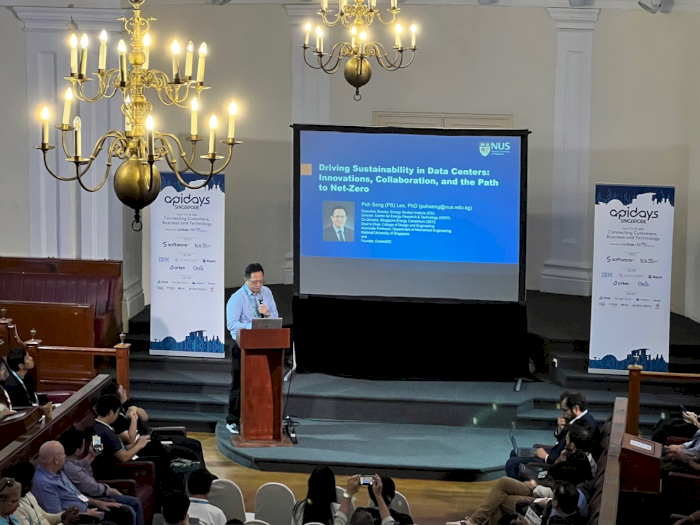
It delves into how the rapid rise in data traffic has led to the electricity of data centres to be comparable with that of the top 5 nations’ electricity use — China, United States, India, Russia and Japan.
On top of exploring sustainable innovations such as immersion cooling and direct-to-chip (DTC), the keynote underscored the collaborative potential of policy regulators and industry partners in creating an ecosystem for initiatives and innovation to thrive.
Emerging technologies and the embedding of automation and AI in operational processes also have the potential to accelerate our progress to net-zero, using monitoring systems and data-driven processes to improve efficiency.
Continuing with the strong focus on emissions reductions strategies — Faiz Mulla, Sustainable Software Technical Product Leader at IBM — explored various strategies from leveraging on operational efficiencies, to re-inventing the way we approach upstream and downstream supply-chains to effectively decarbonize organisations.
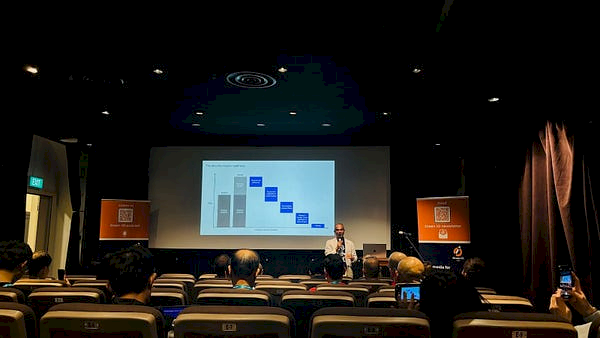
In “State of IT Sustainability: a focus on tooling and transparency”, the Green IO Founder, Gael Duez, provides an honest overview of what drives the move toward greener IT (mostly a venom of sustainability reporting, datacenter regulations and circular economy bills), what delays most organizations (mostly data quality) and what empower them: NGO and tooling. To increase transparency in the tooling he presented a beta version of the work he co-lead at the NGO Boavizta to maintain a repository of all IT Sustainability tools worldwide. Some early findings suggest that a large majority focus on Carbon and energy only, most are open-source but not necessarily transparent about the data inputs and the models used and too much concentrated in Europe.
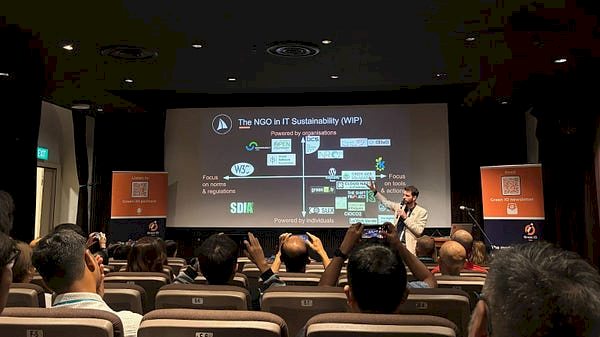
Continuing with the narrative of tools, development and collaboration, “Harnessing Green IT: Optimising code and clouds to reduce GHG emissions” with Timothée Dufresne and Jai Prakash aptly explores best practices to guide software development teams looking to explore green software development. From focusing on customer-centric product design to Data Life Cycles — the emphasis on circularity is clear. I’d even go so far as to propose that circularity is a missing step modern software development is missing. With the emphasis on Agile methodology and CI/CD, circularity is the natural next step we ought to take.
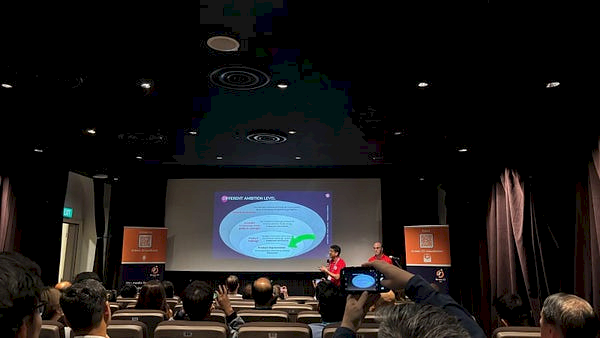
In “Building with the Planet in Mind: Accelerating Green Software Delivery using SustainAgility” by Sandeep Joshi, the insightful sharing brings us a key process that rounds the previous sharings into a cohesive narrative: a planet-positive business strategy anchored in being nimble, growth oriented, hyper-connected while optimising cost and relying on technology driven by the needs of people and customers.
“A Plug-and-Play Framework for Digital Sustainability” by Ian Chew, poses the question: How do we collectively work together to address the scale and speed at which we decarbonise the grid?
While it may seem like an insurmountable task, the speaker proposes the SWUP Framework — focusing on Speed, Weight (for your page), User Journey and consideration of Personal Habits to better understand and adhere to green web development practices, as a means to include sustainability in design and digital development.
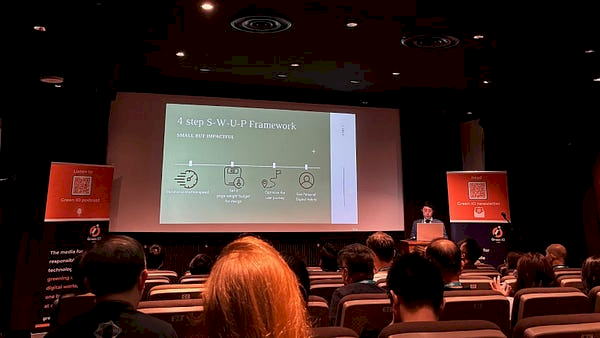
Leveraging on the narrative of Green Web Development, “The Nuance of Quantifying Digital Carbon Emissions” by Fershad Irani demystifies and clarifies the common misconceptions in terms of estimating and measuring emissions. Do they really mean the same thing? (They do not), and what tools can be used to facilitate green software development for beginners.
In “Application and platform optimization through power analysis with Kepler.” by Balakrishnan B and Philippe Benedetti, the discussion acknowledges that cloud providers energy consumption reporting is not mature and the need for legislation are the main drivers for Kepler, a monitoring tool user for customer sustainability reporting instead of relying on estimation. Knowledge of our energy use enables practical actions and stakeholder transparency within tech ecosystems.

In the vein of leveraging tech to drive our net-zero “Harnessing the Universal Impact API: Transforming Nature into an Engagement Tool” by Dr. Simon JD Schillebeeckx explores the core question of : “Can we make planet-positive action profitable?”
The speaker offers perspectives in making current products and the way we behave shift towards sustainability and greener practices. Again, the concept of sustainability being an investment, not a tradeoff or a cost is reiterated through concrete examples. Use cases explored in tree-planting initiatives and serving underprivileged communities, exemplify how positive social impact can benefit the bottomline of tech corporation, and go beyond this by diving into regenerative efforts.

All that’s great? So what about corporates, especially if my company is large, complex, and based in so many different countries? In “Leading the transition towards responsible Tech at L’Oréal” by Faustina Requena, these questions are answered, giving a balanced perspective into the benefits and challenges faced by the company in their green strategy. The speaker outlines the lack of corporate awareness, change resistance in resource usage optimisation, implementation, lack of level of maturity of technology ; reliability and relevance of data and the need for better quantitative measures as key challenges that posed barriers to their net-zero objective.
Their mitigation and overarching solutions to these challenges and their long term approach includes partnering with impact-driven start-ups, and involving top management in sustainability strategy offers multiple ways to enhance our organisational culture and make complex challenges like cloud optimization achievable for such a global company.
Shifting our focus to tech consulting organisations, we gain a different perspective from “Notes from Building the DNA of a Sustainable Organisation” by Keziah Quek.
Perhaps our fixation on technology can make us forgo a key asset needed in sustainable digital transformation — skills. Skillsets to transition requires systemic approaches : establishing structure and governance; process metrics and tools; visible leadership and engagement; and ESG Workforce Transition. All of which work towards continuous improvement and need contextualised realignment with a company’s business goals.
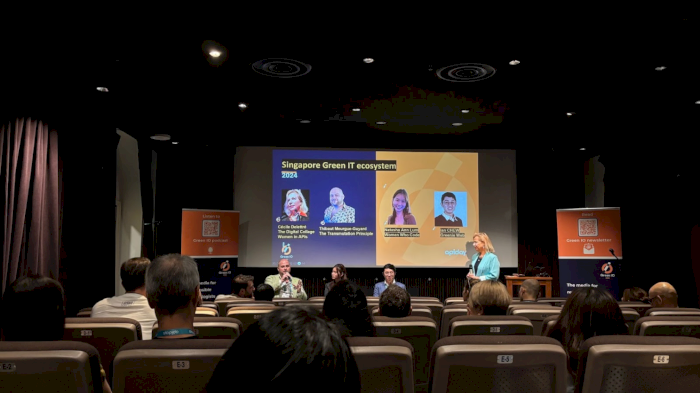
A round table discussion on the Green IT Ecosystem featuring Natasha Ann Lum, Thibaut Meurgue-Guyard, Cécile Delettré and Ian Chew explored what sustainability truly means in a technological hub like Singapore — where different business interests and its status as a cultural melting pot all diverge into different needs and perspectives when it comes to addressing a complex subject. How do we align diverging interests of the stakeholders to benefit everyone in our community?
All of these perspectives and changes create a new social fabric and culture in the technological landscape.
The Green IO Conference rounded the day off with “A nuanced approach on AI costs and benefits for the environment” by Joanna Reijgersberg-Siew.
It is no doubt that AI is here to stay, but how can we reconcile and offset the immense environmental impact it is set to have?
Carbon awareness, intelligence and a focus on energy-efficient technologies offer some reprieve in mitigating environmental impact driven by these key factors:
“1. Intelligent use of hardware
2. Opting for Green Data principles
3. Selecting the right model & APIs for serving models
4. Load shifting in space and time based on renewable energy mixes”
Indeed, the topics and discussions explored in the day of sustainable-tech offer a comprehensive roadmap towards a greener, more responsible technological future, emphasizing collaboration, innovation, and a profound shift in mindset towards sustainability as a core driver of progress.
Join +2000 responsible readers

Green IO newsletter
Once a month, carefully curated news on digital sustainability and Green IO contents delivered in your mailbox